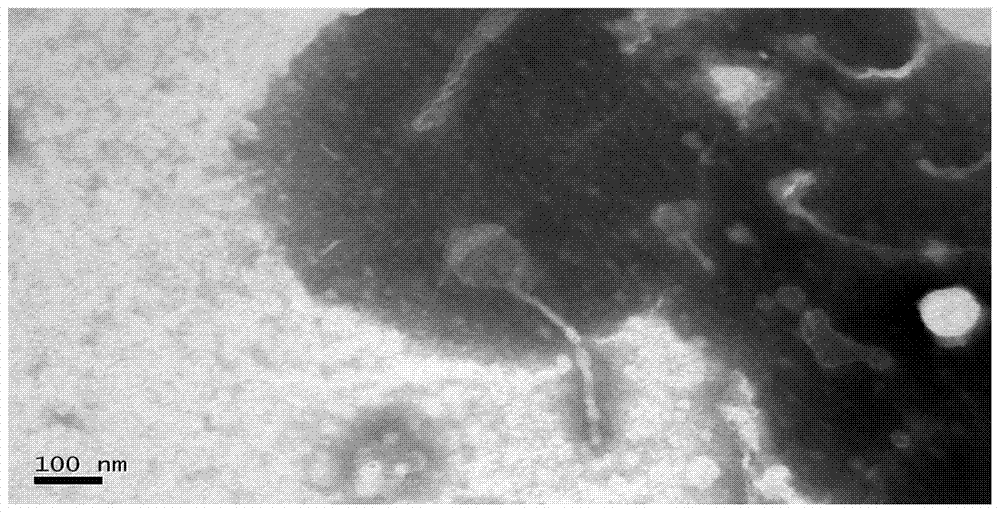Acinetobacter baumannii phage and its application
A technology of Acinetobacter baumannii and bacteriophage, applied in the field of microbial engineering, can solve the problem of too high specificity requirements of host bacteria, and achieve the effects of high clinical application value, small toxic and side effects, and high safety.
- Summary
- Abstract
- Description
- Claims
- Application Information
AI Technical Summary
Problems solved by technology
Method used
Image
Examples
Embodiment 1
[0016] Example 1 Isolation and preparation of Acinetobacter baumannii phage
[0017] (1) Sewage collection and treatment
[0018] The sewage was collected from the untreated sewage station of the First Affiliated Hospital of the Third Military Medical University, centrifuged at 10,000 r / min at 4°C for 10 minutes, and filtered with a 0.22 μm filter membrane to obtain the supernatant.
[0019] (2) Specific amplification of Acinetobacter baumannii phage
[0020] Get 100mL of the supernatant obtained in step (1), add 50mL LB liquid medium and mix well, add Acinetobacter baumannii host bacterial liquid (OD 600nm (0.6) 2mL. After mixing, place in a constant temperature shaker at 37°C and shake at 160r / min for overnight culture. The next day, centrifuge at 10,000r / min for 10min at 4°C, and take the supernatant. This step is phage amplification culture.
[0021] (3) Determination of the presence or absence of specific phages by spot assay
[0022] The supernatant that step (2) obta...
Embodiment 2
[0025] Embodiment 2 Purification of Acinetobacter baumannii phage
[0026] The phage stock solution that obtains in embodiment 1 is diluted to 10 with LB liquid culture medium 7 Double layer agar plate detection was carried out according to the method of step (3) in Example 1. Use an inoculation loop to pick a single phage plaque with regular shape and smooth edges, and inoculate it into 2 mL of Acinetobacter baumannii host bacterial solution (OD 600nm 0.6), shake culture at 37°C at 160rpm / min for 4-6h, the solution becomes clear, indicating that the bacteria are lysed, centrifuge at 10000r / min for 10min at 4°C. The finally obtained supernatant was sterilized by filtration with a 0.22 μm microporous membrane. Repeat the above process 3 to 5 times to obtain the purified phage, which is named SWH-Ab-1, and is preserved in the China Center for Type Culture Collection. The address of the preservation unit is: Wuhan University, Wuhan, China, and the preservation number is CCTCC M...
Embodiment 3
[0027] Example 3. Titer determination and preservation of phage
[0028] The purified phage sample in Example 2 was diluted to 10 with LB liquid medium 7 times, take 10 μL sample, add to 0.2mL Acinetobacter baumannii host bacterial solution (OD 600nm 0.6), then adopt the double-layer agar plate culture method of step (3) in Example 1 to cultivate the phage, and get a plate with an appropriate density to calculate the number of plaques. Do 3 repetitions, and the calculation of phage titer takes the average value obtained from 3 repetitions. The titer of phage (pfu / mL)=the number of plaques on the plate with appropriate density×dilution×100. The results were measured: the titer of the phage was 8×10 9 pfu / mL. Add sterile glycerol to the final phage to a final concentration of 30%, and store at -80°C for future use.
PUM
| Property | Measurement | Unit |
|---|---|---|
| Potency | aaaaa | aaaaa |
Abstract
Description
Claims
Application Information
 Login to View More
Login to View More - R&D
- Intellectual Property
- Life Sciences
- Materials
- Tech Scout
- Unparalleled Data Quality
- Higher Quality Content
- 60% Fewer Hallucinations
Browse by: Latest US Patents, China's latest patents, Technical Efficacy Thesaurus, Application Domain, Technology Topic, Popular Technical Reports.
© 2025 PatSnap. All rights reserved.Legal|Privacy policy|Modern Slavery Act Transparency Statement|Sitemap|About US| Contact US: help@patsnap.com



